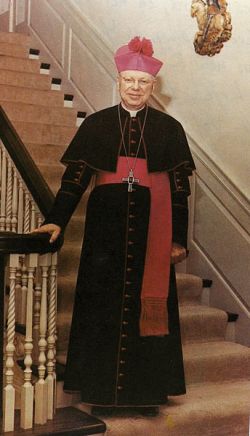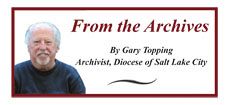Bishop Robert J. Dwyer: Utah's first native priest

By Gary Topping
Diocese of Salt Lake City archivist
Utah Catholics might do well to add June 11 to the list of local anniversaries they celebrate, for it was on that date in 1932 that Bishop Robert J. Dwyer, Utah’s first native priest, was ordained. The date marked not only a maturation of the diocese, but also the beginning of a remarkable ecclesiastical career.
Bishop Dwyer, the only child of John and Mabel Dwyer, was born in 1908 and grew up in a now historic house at 1235 Second Ave., just a block from the streetcar line that would deposit the family at the main entrance of the Cathedral of the Madeleine on Sunday mornings. It was there that he received the sacraments of Baptism, Confirmation, First Holy Communion and Ordination.
It seems that Bishop Dwyer, a bookish young man with a lifelong dislike for athletics and a penchant for stumping his mother with long and archaic words, was inclined to the life of a scholar and priest from an early age. Feeling a desire to fit in, he got a date for his high school prom, bought a new suit, learned a few dance steps, and borrowed his father’s new car. But things began to fall apart, for when he picked the girl up, he put her in the back seat! Experiences like that may have encouraged him to apply for admission to the seminary, which he did at the end of his junior year.
Once Father Dwyer was ordained, Bishops Kearney and Hunt lost no time in finding assignments for the energetic young priest. In addition to teaching at Judge Memorial Catholic High School and St. Mary of the Wasatch, Fr. Dwyer became chaplain of the Newman Club at the University of Utah, assistant pastor of the Cathedral parish (he would eventually become rector), occasional substitute for Bishop Hunt on his "Catholic Hour" radio broadcasts on KSL, and editor of the Intermountain Catholic. In addition to putting the newspaper together each week, he wrote no fewer than two weekly columns and most of the local news stories.
Perhaps sensing Fr. Dwyer’s wish for an even wider scope for his talents, Bishop Hunt sent him to Catholic University to work on a Ph.D. in history, which he received in 1941. His dissertation was published under the title The Gentile Comes to Utah, and remains today one of the basic books of Utah history.
His talents did not go unnoticed; in 1952 he was ordained second Bishop of Reno, a diocese that had only been created in 1931. His years in Reno were tumultuous, for they saw an ambitious building program in response to vast population growth (including the development of Las Vegas), remodeling of St. Thomas Aquinas Cathedral, and the Second Vatican Council, of which Bishop Dwyer attended all four sessions.
In 1966 he became Archbishop of Portland, Ore. Although he had sustained a heart attack in 1961, Bishop Dwyer still felt able to undertake even greater endeavors, but the assignment to Oregon became almost too much for him. As a proponent of the Vietnam War and a prominent spokesman for conservative Catholicism, his appointment to the largely liberal archdiocese was greeted with outrage and open protest, including even an antiwar demonstration in the midst of one of his Masses at the Cathedral. Once again in ill health, he retired in 1974 and died in 1976 (correcting page proofs for a newspaper article as they drove him to the hospital).
Like most people, Bishop Dwyer was a man of contradictions. A renowned dinner party host, he had a wicked sense of humor (his impression of a gargoyle was memorable), and a devoted coterie of friends.
On the other hand, he could show a sudden flash of Irish temper: One afternoon he suspended a priest he had ordained only that morning!
Bishop Dwyer outlived the era in which he was born: An old-fashioned Prince of the Church, he had a monarchical style and a penchant for lavish vestments and elaborate liturgy that fit poorly into the Post-Vatican II Church. Utahns nevertheless should celebrate the achievements of this most remarkable clergyman, the first to emerge from our midst.
© Copyright 2024 The Diocese of Salt Lake City. All rights reserved.


Stay Connected With Us